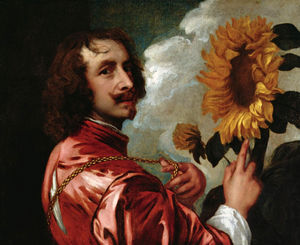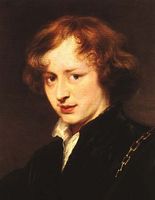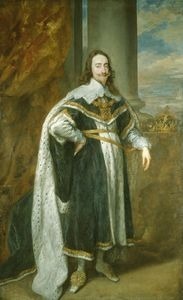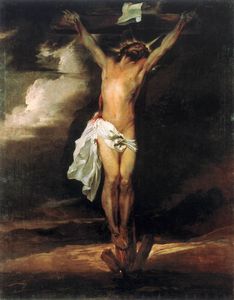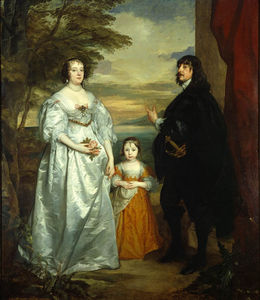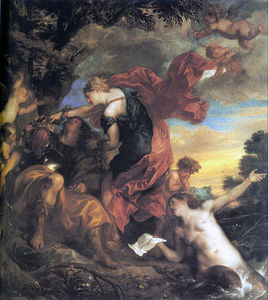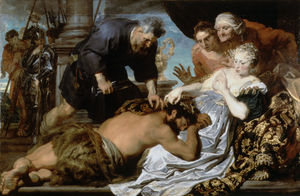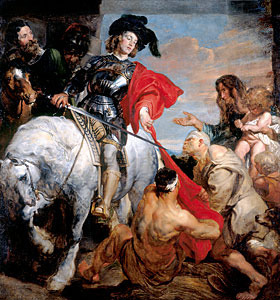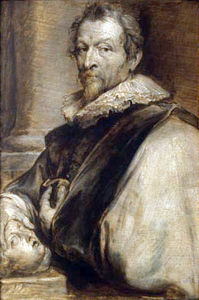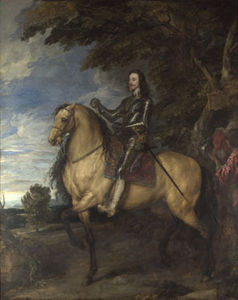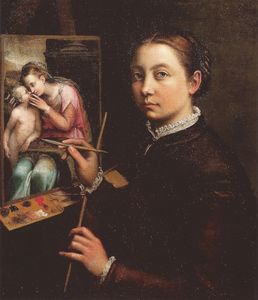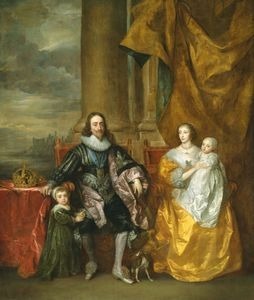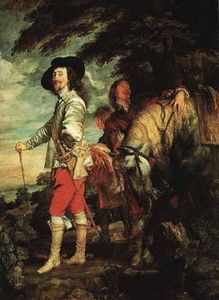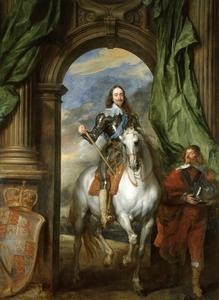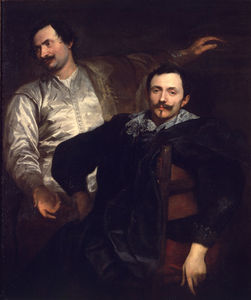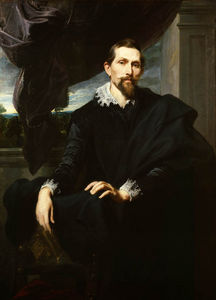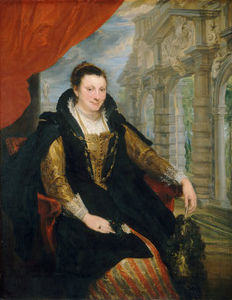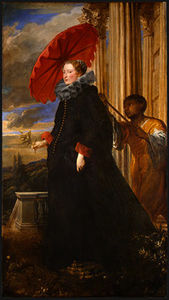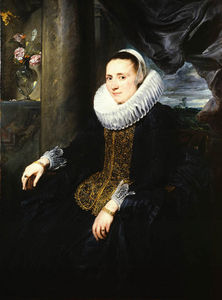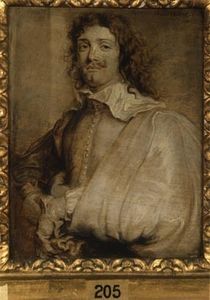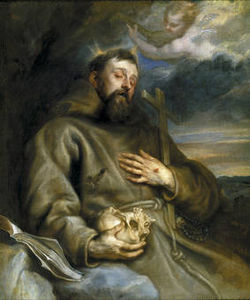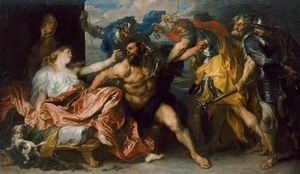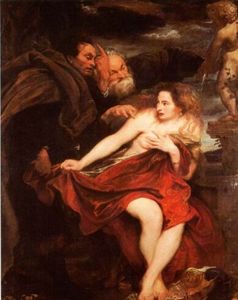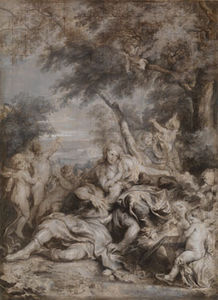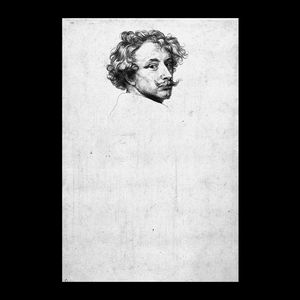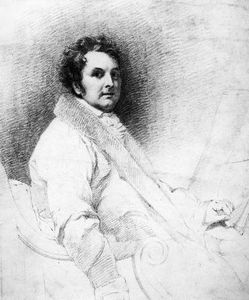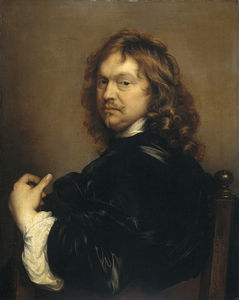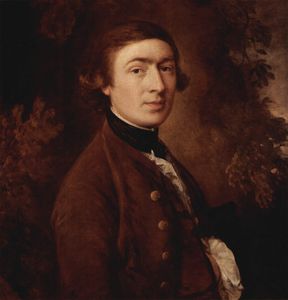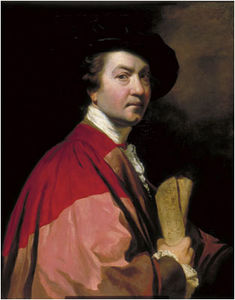Anthony van Dyck
- Short Name:
- van Dyck
- Alternative Names:
- Antoon Van Dyck, Anthonis van Dyck
- Date of Birth:
- 22 Mar 1599
- Date of Death:
- 09 Dec 1641
- Focus:
- Paintings, Drawings
- Mediums:
- Oil, Wood, Other
- Subjects:
- Figure, Scenery
- Art Movement:
- Baroque
- Hometown:
- Antwerp, Belgium
- Anthony van Dyck Page's Content
- Introduction
- Artistic Context
- Biography
- Style and Technique
- Who or What Influenced
- Works
- Followers
- Critical Reception
- Bibliography
Introduction
Anthony van Dyck studied under Peter Paul Rubens and was one of his most accomplished students. Van Dyck's career flourished and he went on to become England's leading court painter.
Using his own compositional techniques, van Dyck was soon ranked alongside Titian in terms of style and the relaxed elegance of his portraits helped shape English portraiture for almost two centuries. Anthony van Dyck was particularly well-known for redefining the iconographical style as well as his fresh approach to new color schemes.
As well as portraits van Dyck also painted biblical and mythological subjects and was an accomplished etcher and engraver in his own right. He would often sketch his works as practise before executing the final version onto canvas.
His etchings in particular show his great ability to define light and shadow contrasts and his dexterity in creating fine lines and detail to ensure a realistic rendering of the sitter.
Anthony van Dyck Artistic Context
Flanders' art scene prospered during the 17th century and the country produced many talented artists who were in great demand across Europe.
This heralded a new era in Counter-Reformation art as well as art from the Protestant North, as Flanders combined these tastes and styles.
Anthony van Dyck was the next big artist after Rubens and one of his former students. He gained international recognition for his works and socialized with the Royal courts and aristocracy of Europe, especially those who supported the Counter-Reformation. Van Dyck's work defined elegance and sophistication and helped establish a new era in English portraiture.
Anthony van Dyck Biography
Born Anthonis van Dyck to a wealthy cloth merchant in Antwerp in 1599, this red haired boy went on to become the next big painter in the Western world. From an early age Anthony van Dyck showed a keen interest and promising talent in both painting and drawing and this was noted by his mother. She convinced his father to let him finish his schooling and serve as an apprentice under Hendrick van Balen in order to nurture his talent.
His mother's intuition paid off and van Dyck's career soon launched. Together with fellow artist and friend, Jan Brueghel the Younger, he opened a tiny, private studio and accepted various commissions from the local people of Antwerp. Word soon got round of this new, young artist and he was later accepted to the studio of Peter Paul Rubens. From then on, Anthony van Dyck was a recognized artist across Europe.
He completed a total of 99 paintings, 72 of which were portraits. It is believed that Rubens encouraged him to focus on portraiture as it was obvious that this is where his talent lay. The artist's portraits were mostly of subjects from Royal and aristocratic circles whom he had met on his pilgrimage to Italy.
As well as portraits, van Dyck spent a great deal of time painting religious works in Antwerp and these were in great demand from local churches and royalty and the artist was eventually made England's leading court painter.
No other artist has lived such a rich life as Anthony van Dyck and this was most probably due to his extremely sensitive nature and devoted relationship with his mother. Just like his paintings, van Dyck's life is a rich picture full of dramatic events.
Anthony van Dyck Style and Technique
Van Dyck's works are known for their smooth finish and bright, bold color schemes, namely his signature use of reds and browns to define, depth, emotion and shape.
The artist became popular for reinventing iconographical aspects in his portrait painting. He depicted his subject's naturally while at the same time ensuring their social status was intact.
Through emphasizing natural beauty, van Dyck was able to elevate the status and presence of his sitters. His works were not overly-dramatic and this made him popular among the Protestant courts of England.
Van Dyck was most noted for his extensive and brilliant use of the color palette. He had a talent for mixing the right tones to create a vivid image that would render the reality of the moment and uplift the human spirit.
Historical:
The artist's historical works were less prominent in his collection and only a few of them were executed. Most of these works were created on his second return to Antwerp after Italy and they were mainly done in cartoon form, heralding the lives of ancient Roman/Greek historical characters and leaders.
Religious:
Van Dyck's works in this genre were heavily influenced by Rubens, especially in terms of their composition and style. These works also contain dominant iconographical elements in the spatial dimension and with regards to their refined coloring.
Drawing inspiration from his Catholic upbringing and motivated by his desire to represent the holy figures in excellence, van Dyck brought a fresh approach to these works, painting them in utmost beauty.
It's likely that his religious works were also influenced by his time in Venice when he was studying at the Venetian school and exposed to portrayals of important saints and subjects from the biblical narrative.
Who or What Influenced Anthony van Dyck
Van Dyck's three greatest influences were Titian, van Balen and Rubens. Yet, his very first inspiration was most likely his mother, who was a skilled embroiderer who presumably sketched her work before executing it onto the tapestry.
Van Dyck also drew upon the classic styles of the Venetian art school when he made his trip to Italy and was also influenced by the various art schools that promoted the teachings of the Counter-Reformation.
Hendrick van Balen:
Van Dyck began his apprenticeship under the well-known Flemish artist at the age of 10. Van Balen showed no immediate influences on van Dyck's oeuvre but rather it can be seen in van Dyck's traditional approach to the Flemish style of landscape painting. Here the subject matter contained intense detail and always had a psychological rendering in the overall execution. Furthermore, van Dyck fused the concepts of the realistic rendering of nature into a pastoral atmosphere that looked to elevate the sitter.
Peter Paul Rubens:
Rubens was most likely van Dyck's biggest influence after Titian. Van Dyck worked as Rubens' student in his vast studio at the age of 15. Rubens noted the young artist as his best pupil and constantly acknowledged his remarkable talent and style.
It was because of Rubens that van Dyck travelled to Italy and made a name for himself, at the same time meeting an important acquaintance of the English Courts. It's believed that Rubens also persuaded his young pupil to focus on portraiture painting as he could see that this was van Dyck's greatest strength.
Titian:
Van Dyck had a strong affiliation for the work of Titian and sketched numerous books and pages of his works in both England and Italy. Drawing on Titian's subject matter van Dyck created his own narrative and style.
Like Titian, van Dyck included sweeping landscapes and painted his male patrons in equestrian poses upon their horse. Van Dyck enjoyed painting his main characters as the core focus in his works and did not create an overflow of various other narratives as Rubens had done.
In following Titian, van Dyck would paint the main characters on a large scale to show the in-depth detail of the event. He also preferred to evoke a psychological rendering of the sitter by including various props or symbolic gestures that would promote the very essence of the poser.
Sofonisba Anguissola:
While in Sicily, van Dyck met the ageing painteress, Sofonisba Anguissola. She was a popular and well-known artist of her day and her work had even been guided by Michelangelo himself.
Van Dyck spent many hours with Anguissola who was now blind and was inspired by her painting techniques. He also took her classical style into account and was even asked to sketch a portrait of her by her son-in-law.
Anthony van Dyck Works
Anthony van Dyck Followers
Anthony van Dyck can be considered the original founder of the British school of art as England had not produced any promising talent during the Baroque era. As King Charles I was a keen art collector and was fascinated by what the fruits of Baroque art had done for the wealthy countries of Europe, he would frequently invite artists to fill his personal galleries with their works.
As one such artist, van Dyck assisted in defining British art tastes and style preferences. He inspired many painters and many went on to become great masters in their own right. Joshua Reynolds, for example, founded the Royal Academy of Arts.
The students of Anthony van Dyck:
Van Dyck employed many students in his studio at Blackfriars but it's thought that he only ever employed artists from Flanders and the Netherlands, as England had not shown any promising talent before his arrival.
Although van Dyck's pupils were not as well-known as those who had studied under Rubens, some were noted including John de Bruyn, David Beek, Joseph Gandy and Adriaen Hanneman. However, a few of van Dyck's pupils became highly influential artists of their time. They include;
Thomas Gainsborough:
Gainsborough was one of van Dyck's greatest followers in terms of his style in portraiture. He too would paint the subject matter in isolation creating a keen focus on the sitter. Unlike van Dyck however, his work would not contain the intense psychological presence of the sitter, although he adopted his technical methods of painting.
Gainsborough was an avid landscape artist and later drew on the classical styles of the Venetian school in his portraits in terms of the iconographical aspect. Focusing on landscape and portraiture, Gainsborough executed his works in elegant formality in the Rococo style.
Joshua Reynolds:
Reynolds emerged during the Romantic period and was the most noted portrait artist of the 18th century. He was deeply inspired by the masters of the Italian Classics and the artistic style of Anthony van Dyck. He too used powerful compositions and poses to convey the sitter's inner psychology and personality through various props and technicalities.
Similarly, Reynolds also used the iconographical style in his works to elevate the true inner characterisations of the sitter that forced a certain image and demeanor. His bright color palette was similar to that of van Dyck and the great masters of the Classical period.
Like van Dyck, Reynolds made the pilgrimage to Italy to study the classic styles of Roman Antiquity and drew inspiration for his portraiture from Titian but always kept to the formality and naturalness of van Dyck.
Reynolds formed an elite club consisting of prominent British artists during the 18th century which strived to preserve the Classic artistic styles and new technical aspects that were being introduced to the art world but at the same time preserving the styles of the masters before them.
Anthony van Dyck Critical Reception
During Life:
Following Rubens, Anthony van Dyck was the most important Flemish painter of the 17th century. He was hugely inspired the Italian artists and greatly admired the work of Titian in particular.
Van Dyck's portraits were defined by their elegance and color and they were in huge demand. In 1641, when Sophia, later Electoress of Hanover, initially met Queen Henrietta Maria, in exile in Holland, she wrote: "Van Dyck's handsome portraits had given me so fine an idea of the beauty of all English ladies, that I was surprised to find that the Queen, who looked so fine in painting, was a small woman raised up on her chair, with long skinny arms and teeth like defence works projecting from her mouth..."
After Death:
Some critics believe that van Dyck's legacy did little more than encourage his successors, including William Dobson and Isaac Fuller, to create elegant, romantic, yet bland portraits. However, in An Essay on the Theory of Painting, 1715, 41, Jonathan Richardson writes, "When van Dyck came hither he brought Face-Painting to us; ever since which time ... England has excel'd all the World in that great Branch of the Art. '
Studying under Rubens, van Dyck was often compared and overshadowed by his teacher's work. Many accused van Dyck of being an imitator of Rubens' paintings or labelled him a mere painter of the aristocracy who aimed to please his patrons.
However, it cannot be denied that van Dyck showed immense talent from a young age and worked hard to establish an international reputation as a competent portraitist. His work was recognised in the Netherlands, as well as in London, Genoa, Rome and Palermo and his talent in this art genre is unrivalled.
Since the early 18th century his full-length portraits have become prized possessions and van Dyck was deemed a match for Rubens. His skill at etching was also acknowledged during the 19th century and was influential in the works of artists such as Whistler.
An artist of many talents ranging from painting to etching, Anthony van Dyck is now best remembered for his depictions of Charles I and his court. Van Dyck defined English portraiture painting and influenced many artists for centuries after.
Anthony van Dyck Bibliography
To read more about Anthony van Dyck and his works please refer to the literary sources listed below.
• Blake, Robin. Anthony Van Dyck: A Life, 1599-1641. Rowman & Littlefield Publishers, 2000
• Brown, Christopher. Anthony Van Dyck. izzoli International Publications, 1999
• Brown, Christopher. The Drawings of Anthony Van Dyck. Pierpont Morgan Library, 1991
• Cust, Lionel. Anthony Van Dyck, a Further Study. 2010
• Depauw, Carl. Anthony Van Dyck as a Printmaker. Rizzoli International Publications, 1999
• Gordenker, Emilie E. S. Anthony Van Dyck (1599-1641) : and the Representation of Dress in Seventeenth-century Portraiture (Pictura Nova 8). Brepols N. V., 2003
• Gritsai, Natalia. Great Masters: Anthony Van Dyck. Grange Books, 2004
• Marshall, Beatrice. Old Blackfriars: A Story of the Days of Anthony Van Dyck (1901). Kessinger Publishing, 2009
• Wheelock, Arthur K. Anthony Van Dyck. Harry N Abrams, 1991
• White, Christopher. Anthony Van Dyck: Thomas Howard, Earl of Arundel (Getty Museum Studies on Art). J. Paul Getty Museum, 1996

